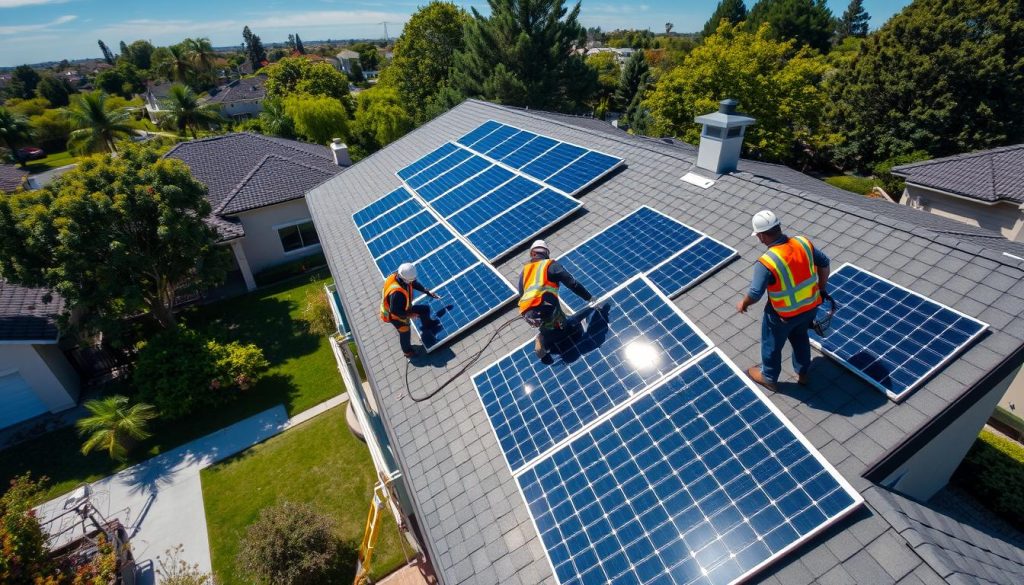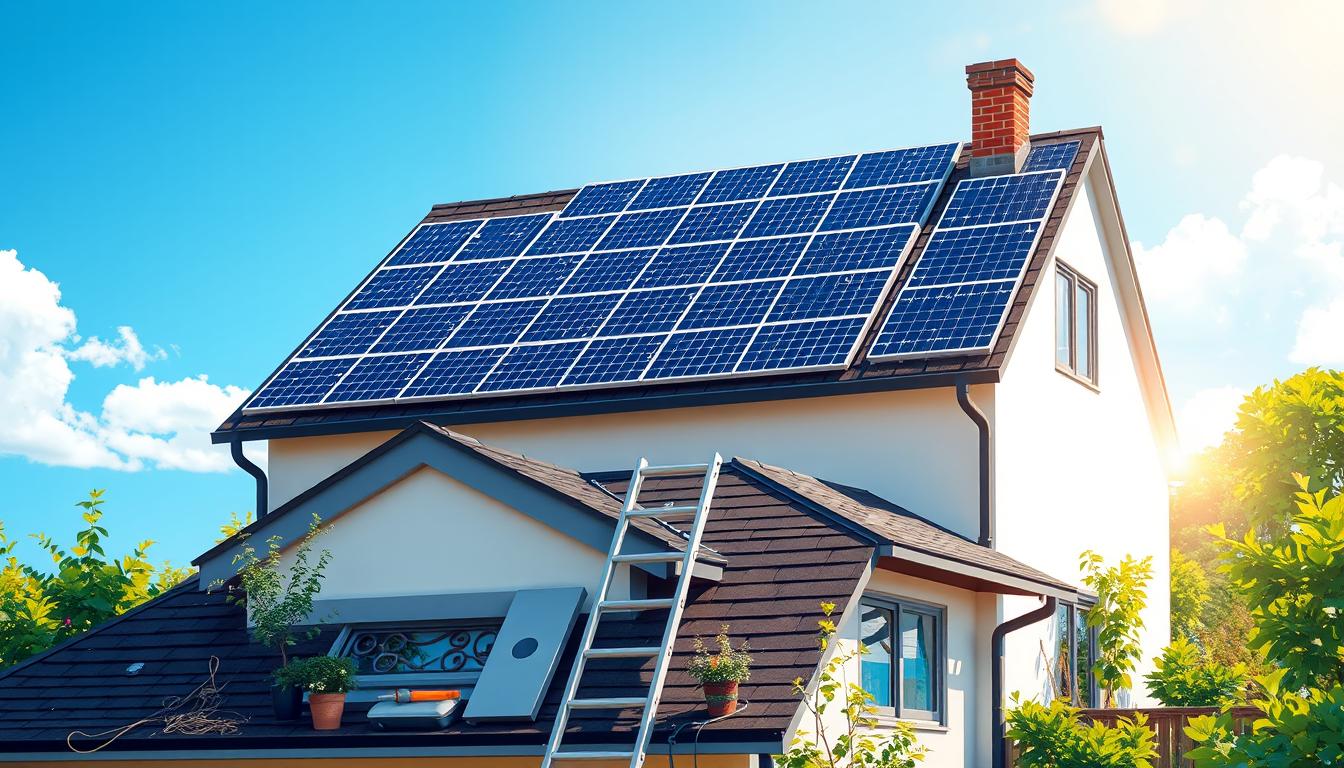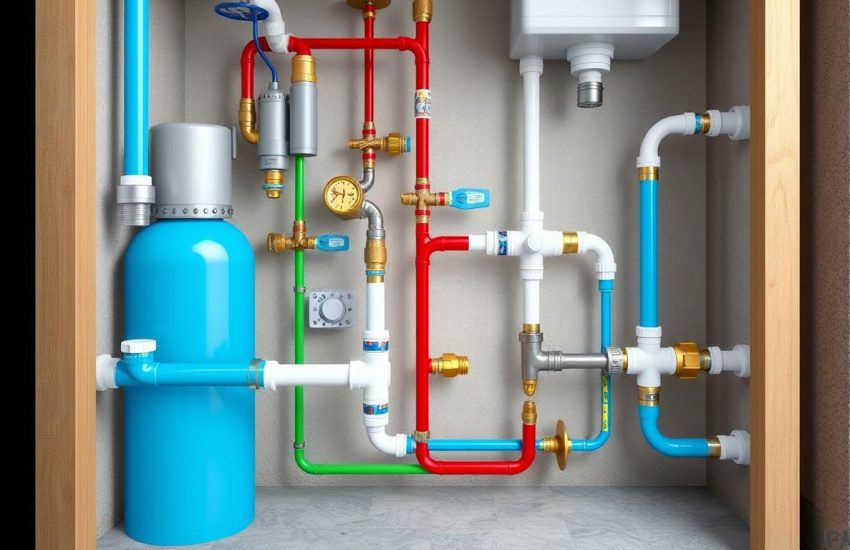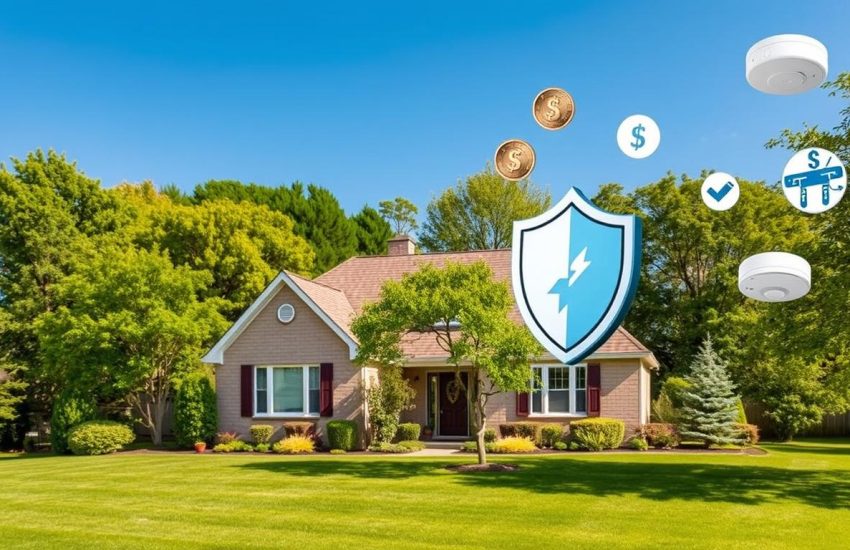Solar Panel Installation: A Complete Guide for Homeowners
Are you making the most of the sun’s energy? Solar panels stand out in the shift to renewable energy. They show we care about our planet. They also make great financial sense for homeowners. Since 2008, more and more families in the USA have started using solar energy. This change is thanks to improvements in solar technology and support from the Solar Energy Technologies Office (SETO).
Many homeowners wonder how solar energy fits into their lives. They think about if their roof works well with solar, other solar options, and how to save money. Learning is the first step to making good choices. Websites like EnergySage’s Community Solar Marketplace and the National Renewable Energy Laboratory (NREL)’s PVWatts calculator are great places to start.
Solar energy does more than just help the environment. It saves you money over time and makes your home energy setup stronger. Imagine paying less for energy and helping the planet at the same time. Your home’s value could even go up. Now, let’s look closer at how solar power works. We’ll see why it’s good for your home and your wallet.
Key Takeaways
- Embracing solar power isn’t just eco-friendly; it’s economically savvy with the potential to increase home value by $15,000.
- Utilizing tools like NREL’s PVWatts help estimate the energy production and financial viability for your specific location.
- The Solar Investment Tax Credit offers significant savings but is set to decrease after 2022, making timely installation advantageous.
- Eligible roofs for peak solar panel performance are typically south-facing with a degree of slope suitable for maximum sun exposure.
- Community solar and solar co-ops are effective ways to enjoy solar benefits, even when individual panel installation isn’t feasible.
- Understanding net metering policies in your area can lead to additional savings by contributing surplus energy back into the grid.
- Complementing a solar energy system with energy efficiency upgrades can further reduce household energy requirements.
Why Focus on Solar Panel Installation?
Many people are now choosing to live in sustainable ways. eco-friendly energy like solar panels is popular among homeowners. Solar panels don’t just cut down on carbon; they also boost your home’s worth. With the latest tech and tax breaks, solar energy is a smart choice.
Solar panels change sunlight into electricity. This process is clean and doesn’t harm the environment. Adding solar panels can even make your home worth $15,000 more. Plus, you won’t have to rely so much on the power grid.
With solar panels, you always have electricity. You might even make money by selling extra power back to the grid. This can help you save money over time.
Putting in solar panels involves steps like building scaffoldings and setting up the panels correctly. You can learn more about it here. Even though they cost upfront, solar panels save money in the long run because they don’t need much upkeep.
Solar panel warranties can last up to 10 years. These systems are long-lasting and efficient. This makes them a great investment. Keeping such systems in good shape is important, just like with HVAC systems. You can learn more about that here.
The world is moving away from old energy sources like oil and coal. Solar energy is a smart and responsible choice. By choosing solar panels, you help reduce harmful emissions and make a cleaner planet for all.
DIY vs Professional Help
Choosing between DIY solar panel installation and hiring a solar installation professional involves safety and cost. Doing it yourself can save money but it’s risky if you’re not used to electrical work. On the other hand, a certified solar installer makes sure your setup is safe and works well.
Professional installers have special training and certification, especially from groups like the NABCEP. This means your solar panels are put in correctly. You can learn more and find experts at benefits of professional solar installations.
| Aspect | DIY Installation | Professional Installation |
|---|---|---|
| Cost | Potential saving of approx $7,000 on labor | Higher upfront due to labor and overhead costs |
| Time Efficiency | Varies based on individual’s skill | Quick, as professionals use advanced tools |
| Safety | Significant risks without proper training | Safer, handled by experienced personnel |
| System Performance | Possible errors could lower efficiency | Optimized design and installation |
| Long-term Savings | Less predictable due to potential for errors | More reliable, with high-quality solar panels expected to last over 20 years |
DIY solar panel installations might not work as well because of small mistakes. These mistakes can even make warranties invalid. But, a certified installer gets you the best materials and deals which are good for a long time.

To wrap it up, DIY might seem cheaper at first. Yet, a solar installation professional ensures your investment pays off for many years. It’s a smart choice, not a risk.
How to Save Money
Finding ways to save money on solar panel installation matters a lot. It’s key for those who own homes. Using the Solar Investment Tax Credit (ITC) can cut down the upfront cost. Knowing about current electricity prices through the National Utility Rate Database helps too. This shows you how much you might save on power bills.
Getting solar panels helps the planet and saves you money. The Solar Investment Tax Credit lowers the system cost by 26%. This makes solar more appealing as electric prices climb.
- Offset up to 80% of electricity needs, reducing monthly electricity bills significantly.
- Average savings over the lifetime of the system can exceed $50,000.
- Solar panel systems typically last for 25-30 years under warranty.
| State | Average Cost (6 kW System) | Average Electricity Rate ($/kWh) | 20-Year Savings |
|---|---|---|---|
| California | $13,566 | 0.1877 | $49,424 |
| Massachusetts | $13,818 | 0.1936 | $30,523 |
| New York | $14,154 | 0.1781 | $26,637 |
| Florida | $10,584 | 0.1247 | $17,976 |
Net metering lets homeowners send extra energy back to the grid for credits. This boosts your savings. Looking at time-of-use rates can also help. It means using solar energy when it’s worth the most, to save more on bills.
Step-by-Step Upgrades
The solar panel installation process follows key steps. It starts with planning and ends with your home powering itself. Every step is important for homeowners who want to use sun power.
- Initial System Design: We begin with an home assessment. This helps figure out if solar will work well for you.
- Permit Acquisition: Getting a permit for solar installation involves talking to local officials. Experts make this easier.
- Installation and Setup: This part includes readying your roof and setting up. Panel installation time frame is often 1-2 days.
- Local Compliance Inspections: This step checks that everything meets safety rules.
- Final Activation: Your system starts working after passing inspections and getting approvals.
Getting a permit quickly and following inspection schedules are key. They help ensure the panel installation time frame doesn’t slip. You’ll eventually get a ‘Permission to Operate’ (PTO), which means you’re all set.
| Component | Description | Specifications |
|---|---|---|
| Solar Panels | Device converting sunlight to electricity. | Photovoltaic effect gathers DC electricity. |
| Inverters | Convert DC output to usable AC power. | Routes electricity between system components. |
| Battery Storage | Stores electricity for later use. | Varied options including lithium and lead-acid. |
| Racking System | Secures panels on roofs or grounds. | Roof mounts preferred for cost efficiency. |
Every part listed in the table is picked during planning. This makes each setup special. It fits the homeowner’s needs and house perfectly.

Final Tips for Success
More people are installing solar panels because we want cleaner energy and the costs of energy are going up. There are good deals that make this choice even better. Make sure your solar panels face south and don’t get shaded for the best results. If your roof is tricky, think about solar shingles or panels that go on the ground. Choosing a trusted solar provider like KC Solar matters a lot for a successful setup.
To keep your solar panels doing great, clean them and check them often. Companies often give tools to watch how well your panels are working. This includes seeing the good they do for the planet. With net metering, you can send extra power back to the grid. This helps you save money and is good for everyone. Solar loans with no interest make going solar easy for more families.
Make sure your solar setup can handle the weather, especially wind. Also, it’s important to keep everything safe from electrical problems. Work with pros who know the local weather and what the community needs. For instance, the team at KC Solar knows a lot about local plans for cleaner energy. Keeping these tips in mind will help you be ready for a future with great solar panels.



